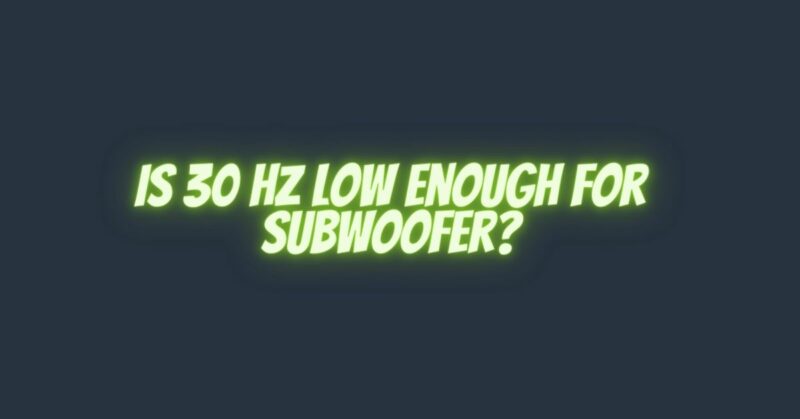Subwoofers are an integral part of any audio system designed to deliver the deepest, most impactful bass frequencies. When considering a subwoofer, one of the essential specifications to examine is its frequency response, particularly its lowest reproducible frequency. Many subwoofers on the market claim to reach as low as 30 Hz, but is this low enough for a subwoofer to truly provide a satisfying bass experience? In this article, we will explore the world of sub-bass frequencies, discuss the significance of 30 Hz, and help you determine if it meets your audio needs.
Understanding Sub-Bass Frequencies
Before we delve into the question of whether 30 Hz is low enough for a subwoofer, it’s essential to grasp the concept of sub-bass frequencies and their role in audio reproduction.
- Frequency Range: Sound is composed of various frequencies, with the human audible range typically spanning from 20 Hz to 20,000 Hz (20 kHz). Sub-bass frequencies are typically defined as those below 60 Hz, though some consider anything below 30 Hz to be true sub-bass.
- Subwoofer’s Purpose: Subwoofers are specifically designed to reproduce the lowest frequencies in the audio spectrum. Their role is to enhance the overall listening experience by providing the deep rumble and impact that regular speakers cannot achieve, particularly for genres like electronic music, action movies, and gaming.
- Bass Perception: Below 30 Hz, sound becomes more of a physical sensation than an audible sound. This low-frequency energy can add excitement and immersion to your audio or home theater setup.
Evaluating the 30 Hz Spec: Is It Low Enough?
When a subwoofer is advertised with a 30 Hz frequency response, it indicates that the subwoofer can reproduce frequencies as low as 30 Hz. However, whether 30 Hz is low enough for your specific requirements depends on several factors:
- Content: Consider the type of content you typically enjoy. For most music genres, including rock and pop, a subwoofer that can reach 30 Hz will suffice, as the majority of musical bass notes typically don’t extend significantly below 30 Hz. However, if you are a fan of electronic music or enjoy movies with deep, impactful bass effects, you may benefit from a subwoofer capable of reaching even lower frequencies.
- Room Size and Acoustics: The dimensions and acoustics of your listening room are crucial factors. Larger rooms may require more powerful subwoofers capable of reaching lower frequencies to ensure even bass distribution throughout the space.
- Personal Preferences: Your personal taste and preferences play a significant role. Some listeners are content with sub-bass that extends down to 30 Hz, while others seek the visceral sensation of sub-bass frequencies below 20 Hz.
- Budget: High-quality subwoofers with the ability to reproduce very low frequencies can be costly. Assess your budget when making your decision.
- Subwoofer Placement and Calibration: Proper subwoofer placement and calibration are essential for achieving optimal performance. Even a subwoofer capable of 30 Hz won’t deliver its full potential if not set up correctly.
In conclusion, a subwoofer with a 30 Hz frequency response can provide satisfying bass for many audio enthusiasts, especially when used appropriately and within the context of the content you enjoy. However, the suitability of 30 Hz as the lower limit for your subwoofer depends on your specific audio preferences, room size, and budget. If you crave the deep, thunderous sub-bass frequencies or have a larger listening space, you may want to consider subwoofers capable of reaching even lower frequencies. Ultimately, the choice of a subwoofer should align with your individual needs and preferences, as the audio experience is subjective. Always explore different subwoofer options and conduct listening tests to find the one that best suits your requirements.


